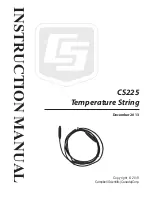Reviews:
No comments
Related manuals for SS-30C

FSCA-01
Brand: ABB Pages: 52

M15
Brand: K&K Pages: 6

ProX
Brand: QCON Pages: 4

G200
Brand: BADODOSECURITY Pages: 8

CR10 PROM
Brand: Campbell Pages: 8

CS225
Brand: Campbell Pages: 22

R1300
Brand: Omnex Pages: 9

MiniTrack LX2
Brand: Omegon Pages: 6

Smart Panel
Brand: WATERLOO Pages: 8

Wisotronic
Brand: WAREMA Pages: 112

750-880
Brand: WAGO Pages: 414

Blitz
Brand: V2 Pages: 48

BBZK
Brand: Bardiani Pages: 96

CDAU-01/04
Brand: Eaton Pages: 4

Wireless Blade FX Controller for Wii
Brand: Datel Pages: 2

SYSMAC C500-NC222-E
Brand: Omron Pages: 164

E4KP ENTRYCHECK
Brand: SDC Pages: 6

Atmos Sigma
Brand: MX Pages: 12

















